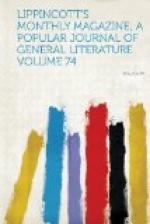“The puttee-dar (pugri, or turban),” continued my companion, “is a neat compact turban, in general use by Hindus and Mohammedans; the joore-dar is like the puttee-dar, except that it has the addition of a knot on the crown; the khirkee-dar is the full-dress turban of gentlemen attached to native courts; the nustalik is a small turban which fits closely to the head, and is worn for full dress at the Mohammedan durbars or royal receptions; the mundeel is the military turban, with stripes of gold and ends; the sethi is like the nustalik, and is worn by bankers; the shumla is a shawl-turban; and I fear you do not care to know the other varieties—the morassa, the umamu, the dustar, the—”
“Thank you,” I said: “life is short, my dear Bhima, and I shall know nothing but turbans if this goes on, which will be inconvenient, particularly when I return to my home and my neighbor Smith asks me that ghastly question, ‘What do I think of India?’”
“It is a more ‘ghastly’ question as to India than as to any other country in the world,” said the Hindu. “Some years ago, when Mr. Dilke was traveling in this country, a witty officer of one of the hill-stations remarked to him that all general observations about India were absurd. This is quite true. How could it be otherwise? Only consider, for example, the languages of India—the Assamese, with its two branches of the Deccan-goel and the Uttar-goel; the Bengalee; the Maithilee, Tirhutiya or Tirabhucti, spoken between the Coosy and the Gunduck; the Orissan, of the regions around Cuttack; the Nepalese; the Kosalese, about Almora; the Dogusee, between Almora and Cashmere; the Cashmiran; the Panjabee; the Mooltanee, or Vuchee, on the middle Indus; the two dialects of Sindhi, or Tatto, on the lower Indus; the Cutche, on the west coast of the peninsula; the Guserate, spoken on the islands of Salsette and Bombay and the opposite coast of the Coucan, as well as by the Parsees in the cities, where it is corrupted with many words of other languages through the influence of commercial relations; the Coucane, from Bombay to Goa and along the parallel Ghats where it is called Ballagate; the Bikaneere, the Marvare, the Jeypore, the Udayapore, of Rajpootana; the Vraja-bhasha (the cow-pen language) of the Doab, between the Ganges and the Jumna, which is probably the parent of Hindi (or Oordu); the Malooe, of the tableland of Malwa; the Bundelakhande, of the Bundelkhand; the Mogadhe, of Behar; the Maharachtre, of the country south of the Vindhyas; the—”
“It gives me pain to interrupt you, Bhima Gandharva,” I said (fervently hoping that this portion of my remark might escape the attention of the recording angel); “but I think we are at Jabalpur.”




